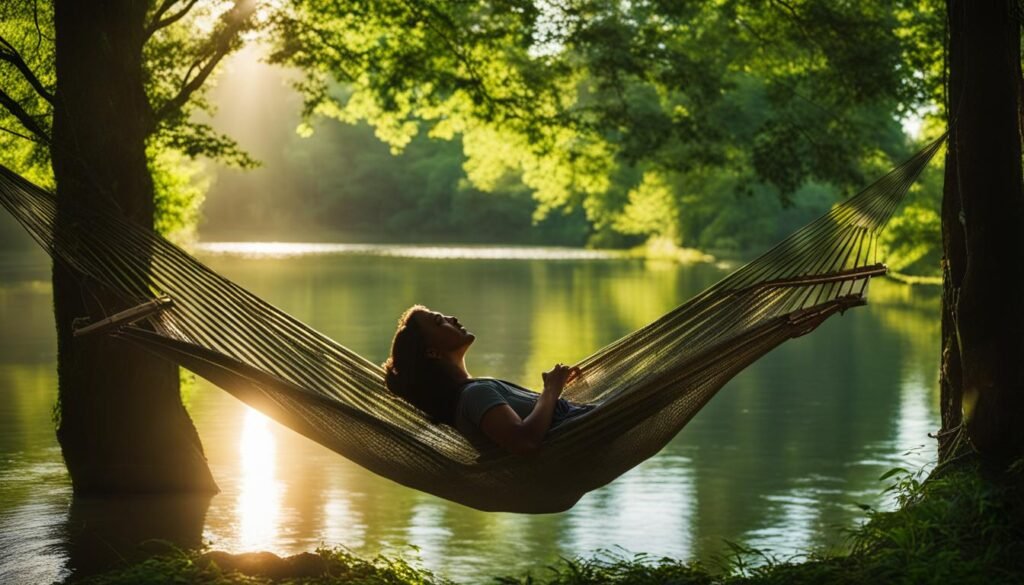How do I Leave a Calm and Peaceful Life?
In our fast-paced society, it’s easy to become overwhelmed and forget to slow down and enjoy life. However, it is possible to live a simpler and more peaceful life. By prioritizing what is truly important, examining your commitments, and doing less each day, you can create a sense of calm and tranquility in your life.
Key Takeaways:
- Identify what truly matters to you and prioritize those things in your life.
- Take a critical look at your commitments and reduce non-essential ones to reduce stress.
- Focus on doing fewer tasks but doing them well to avoid overwhelm.
- Leave buffer time between tasks to avoid rushing and reduce stress.
- Practice mindfulness and being present in every task to find joy and peace.
Decide What is Important
In our busy lives, it’s easy to get caught up in the hustle and bustle and lose sight of what truly matters. To live a calm and peaceful life, it’s essential to prioritize what is important to you. By identifying your passions, the people and activities that bring you joy, and your personal goals, you can create a meaningful and fulfilling path.
Make a list of your priorities, both short-term and long-term. This will help you focus your time, energy, and resources on the things that truly align with your values and aspirations. By prioritizing tasks and activities that are important to you, you’ll find yourself feeling more fulfilled and satisfied with your daily life.
Remember, it’s not about doing everything, but rather doing the things that are most meaningful to you. By prioritizing effectively, you can make the most out of your time and create a sense of harmony and tranquility in your life.
Suggested Priorities:
- Spend quality time with loved ones
- Pursue hobbies and activities that bring you joy
- Work towards achieving your personal goals
- Take care of your physical and mental well-being
- Engage in acts of kindness and make a positive impact
Remember, it’s your life and your journey. By prioritizing what is truly important to you, you can create a sense of calm and fulfillment in your daily life.
Examine Your Commitments
In our modern society, it’s all too common to feel overwhelmed and constantly pulled in multiple directions. With an overbooked schedule and countless commitments, it’s no wonder that stress levels are on the rise. However, by taking the time to examine your commitments and set boundaries, you can reduce stress and create a more peaceful and balanced life.
One of the key steps in this process is learning to say no. It’s important to recognize that you can’t do everything and that it’s perfectly acceptable to decline commitments that don’t align with your values or priorities. By setting boundaries and being selective about how you spend your time, you can ensure that you have the space and energy to focus on what truly matters to you.
Another aspect of examining your commitments is assessing the essential versus the non-essential. Take a critical look at your schedule and determine which commitments are truly necessary and which ones can be eliminated or delegated. This will free up valuable time and mental energy, allowing you to focus on the things that bring you the most fulfillment and joy.
Benefits of Examining Your Commitments:
- Reduce stress and overwhelm.
- Create a more balanced and fulfilling life.
- Make time for activities that align with your values and goals.
- Improve your overall well-being and mental health.
By examining your commitments, setting boundaries, and learning to say no, you can reclaim control over your schedule and create a life that is more in alignment with your true desires. Remember, it’s okay to prioritize your own well-being and happiness. Taking this step towards reducing stress is a powerful way to live a more peaceful and fulfilling life.
| Commitments | Essential? |
|---|---|
| Weekly team meetings | Yes |
| Volunteer work at local charity | Yes |
| Committee membership for professional organization | No |
| Attending networking events | No |
In the table above, you can see an example of how you can evaluate your commitments. By assessing whether each commitment is essential or not, you can make informed decisions about where to allocate your time and energy. This exercise can be eye-opening and help you prioritize what truly matters to you.
Remember, reducing stress and creating a more peaceful life starts with examining your commitments. Take the time to evaluate your schedule and set boundaries. Say no to non-essential commitments and focus on what brings you joy and fulfillment. By making small changes in this area, you can experience a significant positive impact on your overall well-being.
Do Less Each Day
In today’s fast-paced world, it’s easy to get caught up in the never-ending cycle of tasks and responsibilities. We often find ourselves overwhelmed, stressed, and constantly rushing from one thing to another. But what if I told you that by doing less each day, you can actually achieve more? It may sound counterintuitive, but it’s true. By prioritizing your time, focusing on quality rather than quantity, and avoiding overwhelm, you can create a sense of calm and accomplish what truly matters.
Time management is key when it comes to doing less each day. Start by identifying your most important tasks or goals. What are the things that will have the biggest impact on your life or work? Once you’ve identified these priorities, make them non-negotiable. Dedicate your time and energy to these tasks, and let go of the ones that don’t align with your goals. Remember, it’s not about doing everything; it’s about doing the right things.
Another important aspect of doing less each day is to avoid overwhelm. It’s easy to feel like you have to say yes to everything or take on more than you can handle. But the truth is, spreading yourself too thin only leads to burnout and diminished results. Learn to set boundaries and say no when necessary. Focus on what you can realistically accomplish and give yourself permission to let go of the rest. By doing so, you’ll free up mental and physical space for the tasks that truly matter.
Lastly, shift your focus from quantity to quality. Instead of trying to do as much as possible in a day, focus on doing a few things exceptionally well. When you give your full attention and effort to each task, you’ll produce better results and feel more satisfied with your accomplishments. It’s about being intentional and present in what you do, rather than rushing through a never-ending to-do list. By embracing this mindset, you’ll not only do less each day but also do it with excellence.
“The key is not to prioritize what’s on your schedule, but to schedule your priorities.” – Stephen Covey
| Benefits of Doing Less Each Day | Benefits of Avoiding Overwhelm |
|---|---|
| Reduced stress and anxiety | Better focus and concentration |
| Increased productivity | Improved decision-making |
| Enhanced creativity | Increased sense of fulfillment |
| Improved work-life balance | Greater overall well-being |
By doing less each day, prioritizing tasks, avoiding overwhelm, and focusing on quality, you can create a sense of peace and accomplishment in your life. Remember, it’s not about how much you do, but about what you choose to do and how well you do it. So take a step back, reevaluate your priorities, and embrace the power of doing less.
Leave Time Between Tasks
One of the keys to maintaining a calm and peaceful life is to avoid rushing from one task to another. By incorporating buffer time into your schedule, you can reduce stress and create a smoother transition between activities. Buffer time allows you to complete tasks without feeling rushed and gives you a moment to mentally prepare for what’s next.
Imagine a life where you’re not constantly running late or feeling overwhelmed by a never-ending to-do list. Leaving time between tasks allows you to focus more on each activity, giving it your full attention and energy. It also gives you the opportunity to reflect on what you’ve accomplished and celebrate your progress before moving on to the next task.
Use this buffer time wisely by engaging in relaxation techniques such as deep breathing exercises or simply taking a few moments to enjoy a cup of tea or coffee. By intentionally creating space between tasks, you can reduce stress, increase productivity, and experience a greater sense of calm and tranquility in your daily life.

Benefits of Leaving Time Between Tasks:
- Reduces stress and feelings of overwhelm
- Promotes smoother transitions
- Increases focus and attention on each task
- Allows for reflection and celebration of accomplishments
- Creates a more peaceful and balanced daily routine
Example Schedule with Buffer Time:
| Time | Activity |
|---|---|
| 8:00 AM – 8:30 AM | Morning meditation and reflection |
| 8:30 AM – 9:00 AM | Breakfast and enjoying a cup of coffee |
| 9:00 AM – 9:30 AM | Replying to emails and organizing tasks |
| 9:30 AM – 10:30 AM | Work on a specific project or task |
| 10:30 AM – 11:00 AM | Short break for stretching and relaxation |
| 11:00 AM – 12:00 PM | Continue working on the project |
| 12:00 PM – 1:00 PM | Lunch break |
| 1:00 PM – 2:00 PM | Meeting or collaborative work session |
By incorporating buffer time between each activity, you can create a schedule that promotes balance, reduces stress, and allows for a more peaceful and productive day. Remember, it’s not about doing more, but about doing things with intention and giving yourself the space to fully engage and enjoy each task.
Slow Down and Enjoy Every Task
Living in a fast-paced world, it’s easy to rush through our daily tasks without fully experiencing them. We often find ourselves multitasking and constantly thinking about what’s next, losing sight of the present moment. However, by cultivating mindfulness and focusing on the details of each task, we can enhance our sense of peace and contentment.
Mindfulness is the practice of bringing our attention to the present moment, with non-judgmental awareness. When we approach our tasks mindfully, we immerse ourselves in the experience, noticing the sensations, thoughts, and emotions that arise. By paying attention to the details, we can appreciate the beauty and significance of even the simplest activities.
“When you wash your hands, when you make a cup of coffee, when you’re waiting for the elevator – instead of indulging in thinking, these are all opportunities for being there as a still, alert presence.” – Eckhart Tolle
The Power of Attention to Detail
Attending to the details of our tasks not only allows us to fully engage with the present moment but also helps us cultivate a sense of purpose and focus. When we approach our work and daily activities with attention to detail, we become more efficient and effective. Our work becomes an expression of our commitment to excellence.
Moreover, focusing on the details enables us to uncover hidden beauty and discover new perspectives. Whether it’s noticing the intricacies of a painting, the flavors in a meal, or the feeling of water on our skin during a shower, paying attention to the small things enriches our experience and brings a sense of joy and wonder to our lives.
Embrace Mindful Presence
To fully embrace the practice of mindfulness and present-moment awareness, it’s important to create moments of stillness in our day. Find a quiet space where you can sit comfortably and bring your attention to your breath. Allow thoughts to come and go without judgment, bringing your focus back to the sensation of breathing.
As you go about your day, remind yourself to slow down and bring your attention to the task at hand. Notice the sensations, smells, sounds, and emotions that arise. Avoid distractions and resist the urge to rush through. Remember, each moment is an opportunity to cultivate mindfulness, find peace, and live fully in the present.
Table: Benefits of Mindful Presence
| Benefit | Description |
|---|---|
| Reduced Stress | Mindfulness helps reduce stress by shifting our focus from worries and anxieties to the present moment. |
| Enhanced Focus | Practicing mindful presence improves our ability to concentrate, making us more effective in our tasks. |
| Improved Well-being | By savoring each moment and finding joy in the present, we cultivate a greater sense of overall well-being. |
| Deeper Connections | When we are fully present with others, we deepen our connections and experience more meaningful relationships. |
By slowing down and embracing the practice of mindful presence, we can find peace and fulfillment in every task. Instead of rushing through life, let us savor each moment, appreciating the beauty and wonder that surrounds us.
Set Boundaries for a Digital Detox
In today’s hyperconnected world, it’s easy to become overwhelmed and consumed by technology. The constant notifications, social media feeds, and endless scrolling can take a toll on our mental and emotional well-being. That’s why it’s essential to set boundaries and take intentional breaks from our digital devices—a practice known as a digital detox.
A digital detox involves consciously reducing screen time, setting limits on technology usage, and reclaiming time for activities that promote relaxation and connection with the real world. By unplugging from the digital realm, we can create space for more meaningful interactions, increased productivity, and improved overall well-being.
To embark on a successful digital detox, it’s important to establish clear boundaries and guidelines. Consider implementing the following strategies:
- Designate technology-free zones in your home or workplace: Create sacred spaces where devices are off-limits, such as bedrooms, dining areas, or designated workspaces.
- Set specific screen time limits: Determine how much time you want to allocate to technology each day and stick to it. Use apps or device features that track and remind you of your screen time usage.
- Establish technology-free periods: Designate specific times of the day or week when you disconnect from technology completely. Use this time to engage in activities that nourish your mind, body, and soul.
- Practice mindful technology use: When you are using technology, be intentional and mindful. Avoid multitasking and focus on one task at a time. This helps reduce distractions and promotes a sense of calm and presence.
By implementing these boundaries and creating intentional habits, you can experience the benefits of a digital detox. Take control of your technology usage, reclaim your time, and cultivate a sense of peace and balance in your life.

Table: Benefits of a Digital Detox
| Benefits | Description |
|---|---|
| Reduced stress and anxiety | Disconnecting from technology allows your mind to unwind and recharge, reducing stress levels and promoting relaxation. |
| Improved sleep quality | Reducing screen time before bed can enhance the quality of your sleep, leading to increased energy and productivity during the day. |
| Enhanced productivity | By minimizing digital distractions, you can focus better on tasks and accomplish more in less time. |
| Stronger connections | Unplugging from technology allows you to be fully present in your relationships, leading to deeper connections and more meaningful interactions. |
| Increased creativity | When you disconnect from the digital world, you create space for your mind to wander and generate new ideas, fostering creativity and innovation. |
“Technology offers us great conveniences, but it’s essential to find a balance. Take the time to disconnect, recharge, and savor the beauty of the present moment.”
Do Nothing and Create Time for Solitude
Amidst the chaos and demands of modern life, it’s essential to carve out moments of relaxation and solitude. Taking time for yourself allows you to recharge, rejuvenate, and reconnect with your inner self. By intentionally creating space for stillness and quiet, you can find a sense of peace and tranquility.
In a society that glorifies busyness, the idea of doing nothing may seem counterintuitive. However, embracing moments of idleness is crucial for your overall well-being. Whether it’s taking a leisurely walk in nature, indulging in a bubble bath, or simply sitting in silence, these moments of solitude enable you to slow down and reconnect with your inner calm.
Engaging in activities that promote self-care and relaxation is crucial for mental, emotional, and physical health. Give yourself permission to step away from your responsibilities and obligations, even if only for a short time. By prioritizing self-care and embracing the beauty of solitude, you can recharge your energy and find a deeper sense of balance and peace in your life.

Practice Being Present and Appreciate Simple Pleasures
Living in a fast-paced world can often make us feel disconnected from the present moment. However, by practicing mindfulness and cultivating an attitude of gratitude, we can bring more peace and fulfillment into our lives. Mindfulness is the practice of bringing one’s attention to the present moment, without judgment, and appreciating the simple joys that surround us.
When we practice mindfulness, we become fully engaged in our experiences, whether they are big or small. We learn to savor each moment and find beauty in the ordinary. From the warmth of the morning sun on our skin to the taste of a delicious meal, there is so much to be grateful for in every day.
By shifting our focus from the past or the future to the present moment, we can alleviate stress and anxiety. We become more aware of our thoughts, emotions, and physical sensations, allowing us to better respond to the challenges that life throws at us. Mindfulness helps us to slow down, breathe deeply, and appreciate the simple pleasures that can often go unnoticed in our busy lives.
So, take a moment to pause, breathe, and be fully present in the here and now. Embrace the beauty of life’s simple pleasures and let gratitude fill your heart. By practicing mindfulness and appreciating the small joys, you can create a greater sense of peace, contentment, and happiness in your daily life.

The Power of Mindfulness and Gratitude
“The present moment is the only moment available to us, and it is the door to all moments.” – Thich Nhat Hanh
Mindfulness and gratitude go hand in hand, as they both encourage us to be fully present and appreciate the abundance that surrounds us. When we practice mindfulness, we become more aware of the positive aspects of our lives, even in the midst of challenges. By cultivating gratitude, we shift our focus towards the things we are grateful for, leading to a greater sense of happiness and well-being.
Here are some simple ways to incorporate mindfulness and gratitude into your daily life:
- Start each day with a gratitude practice. Take a few moments to reflect on three things you are grateful for, whether it’s a supportive friend, a beautiful sunrise, or a good night’s sleep.
- Engage your senses. When you eat a meal, savor each bite and notice the flavors, textures, and aromas. When you go for a walk, pay attention to the sights, sounds, and sensations around you.
- Take mini mindfulness breaks throughout the day. Pause for a few breaths and bring your attention to the present moment. Notice the sensations in your body, the thoughts in your mind, and the emotions you are experiencing.
- End the day with a gratitude reflection. Before going to bed, think of three things that went well during the day or moments that brought you joy. This practice can help shift your focus towards the positive aspects of your day, promoting a sense of peace and contentment.
By making mindfulness and gratitude a part of your daily routine, you can enhance your overall well-being and create a deeper connection to the present moment. So, slow down, appreciate the simple pleasures, and celebrate the beauty of each day.
| Benefits of Mindfulness and Gratitude | |
|---|---|
| Mindfulness | Gratitude |
| Reduces stress and anxiety | Fosters a positive outlook |
| Improves focus and concentration | Enhances relationships |
| Promotes emotional well-being | Increases resilience |
| Boosts self-awareness | Improves sleep quality |
Embrace Peace in the Outer Banks
When it comes to finding the perfect vacation destination for relaxation and tranquility, look no further than the Outer Banks. This picturesque coastal region offers a peaceful getaway like no other, allowing you to escape the stresses of everyday life and immerse yourself in the soothing embrace of nature.
Picture yourself strolling along the pristine beaches, feeling the soft sand between your toes and listening to the gentle sound of waves crashing against the shore. The Outer Banks’ miles of unspoiled coastline provide the ideal setting for relaxation, where you can unwind and let go of any lingering tension.
For those seeking a deeper connection with nature, the Outer Banks offers a myriad of outdoor activities to rejuvenate your body and mind. Explore the scenic hiking trails that wind through the coastal dunes, where you can immerse yourself in the beauty of the surrounding flora and fauna. Or embark on a kayaking adventure through the tranquil waterways, discovering hidden coves and observing the abundant wildlife.
| Activities | Features |
|---|---|
| Beachcombing | Discover unique seashells and treasures washed ashore |
| Lighthouse tours | Visit historic landmarks and enjoy breathtaking views |
| Wildlife cruises | Spot dolphins, pelicans, and other coastal wildlife |
| Beach yoga | Experience serenity and find inner peace with beachside yoga sessions |
No matter how you choose to spend your time in the Outer Banks, the serene atmosphere and natural beauty will leave you feeling rejuvenated and inspired. So why wait? Book your peaceful getaway to the Outer Banks today and let the tranquility wash over you.
Conclusion
In this fast-paced society, it’s easy to get caught up in the chaos and forget to nurture our inner peace. However, I believe that creating a calm and peaceful life is within our reach. By prioritizing what truly matters to us, simplifying our commitments, and embracing mindfulness and gratitude, we can invite tranquility and happiness into our daily lives.
It all starts with deciding what is important. Taking a step back and identifying our passions, the people we cherish, and the achievements we aspire to accomplish allows us to focus our time and energy on what brings us true joy and fulfillment.
Next, it’s crucial to examine our commitments and set boundaries. We often find ourselves overwhelmed by overbooking our schedules and overcommitting to tasks that don’t align with our values. By learning to say no and eliminating non-essential commitments, we can reduce stress and create more balance in our lives.
Finally, we must slow down, practice self-care, and be present in each moment. By engaging fully in our daily tasks, appreciating the simple pleasures, and expressing gratitude, we can cultivate a mindset of mindfulness and enhance our overall sense of peace and contentment.
I invite you to embark on this journey towards a calm and peaceful life. Embrace the power of prioritization, simplicity, and mindfulness. By doing so, you will discover the tranquility, inner peace, and happiness that have been waiting for you all along.
FAQ
How can I create a calm and peaceful life?
By prioritizing what is truly important, examining your commitments, and doing less each day, you can create a sense of calm and tranquility in your life.
How do I decide what is important?
Take a step back and identify what truly matters to you. Make a short list of your passions, the people you want to spend time with, and the achievements you want to accomplish. Focus your time and energy on what brings you joy and fulfillment.
How can I reduce stress and overbooked schedule?
Take a critical look at your commitments and determine what is truly essential. Set boundaries, learn to say no, and prioritize your time around the things that align with your values and goals. By eliminating non-essential commitments, you can reduce stress and create more balance in your life.
How can I avoid feeling overwhelmed?
Instead of trying to cram as much as possible into each day, focus on doing fewer tasks but doing them well. Prioritize the most important and meaningful activities and give them your full attention. By reducing the number of tasks you try to accomplish, you can avoid the feeling of constant rush and overwhelm, and instead, achieve a sense of satisfaction and peace.
Why should I leave time between tasks?
Leaving time between appointments and activities allows you to focus more on each task without feeling rushed. It gives you a chance to transition and mentally prepare for the next task, reducing stress and promoting a more peaceful state of mind.
How can I slow down and enjoy every task?
Practice mindfulness and being present in every task you do. Slow down and fully engage with each activity, paying attention to your senses, focusing on the task at hand, and avoiding distractions. By living in the moment and savoring each experience, you can find joy and peace in even the simplest tasks.
How can I avoid technology taking over my life?
Set boundaries for yourself and create designated technology-free zones and times. Activate digital well-being features on your devices or use apps that help you regulate your screen time. By limiting your exposure to technology, you can reduce the feeling of chaos and create more space for peace and tranquility.
Why is it important to create time for solitude?
Allow yourself to do nothing and simply be. Take breaks from your busy schedule to relax and recharge. Practice activities like meditation, deep breathing, or simply sitting in silence. By prioritizing moments of solitude, you can cultivate a sense of calm and well-being.
What can I do to be more present and appreciate simple pleasures?
Practice being present in your daily life by paying attention to your surroundings, savoring simple pleasures, and expressing gratitude. Focus on the present moment, be fully engaged, and appreciate the small things that bring you joy. By cultivating a mindset of gratitude and mindful presence, you can enhance your overall sense of peace and contentment.
Where can I go to embrace peace and tranquility?
The Outer Banks is a perfect destination to escape the hustle and bustle of everyday life and embrace peace. Whether it’s enjoying the beautiful beaches or exploring the natural surroundings, the Outer Banks offers a chance to unwind and rejuvenate.






